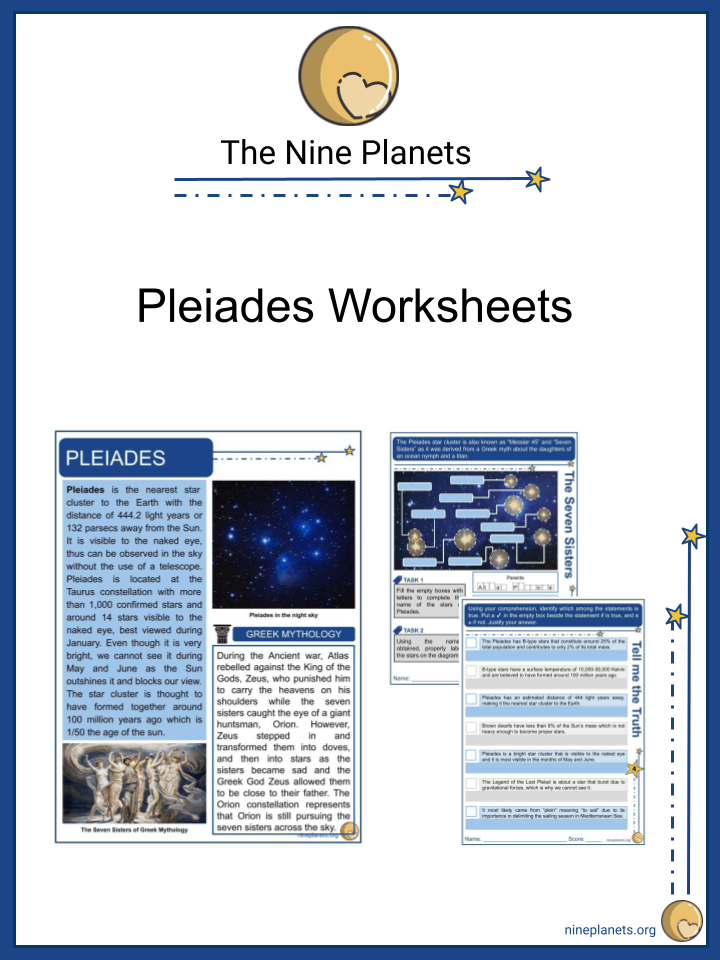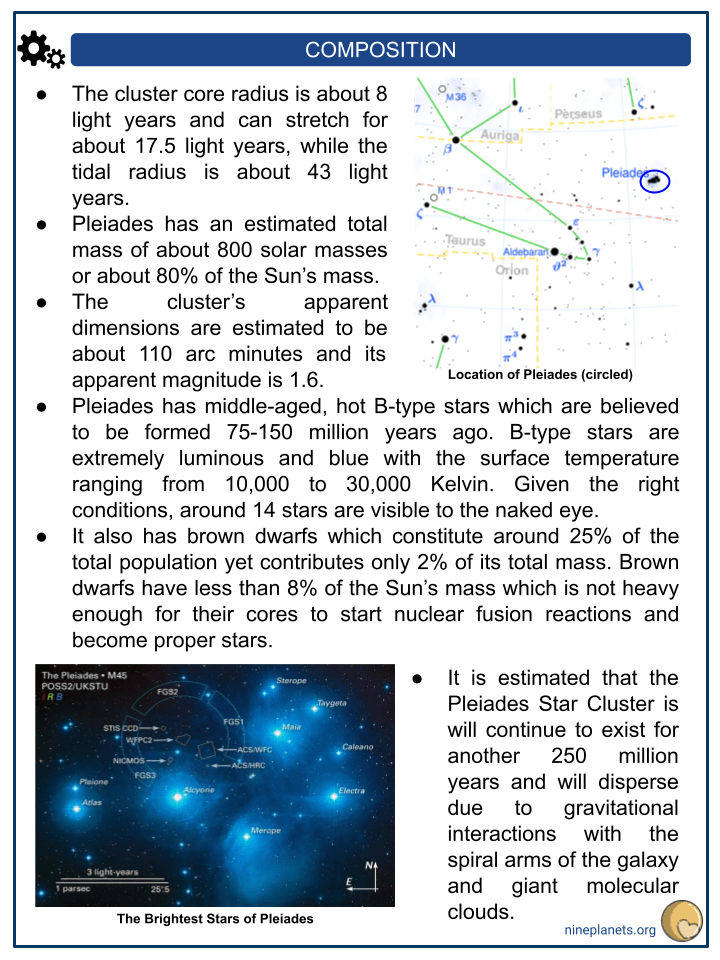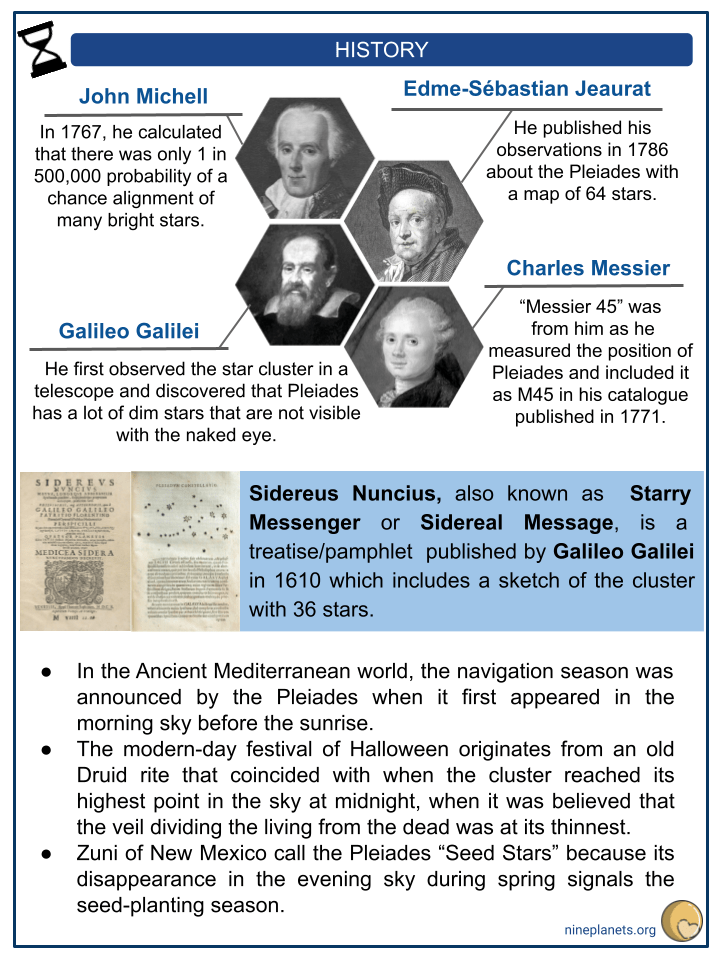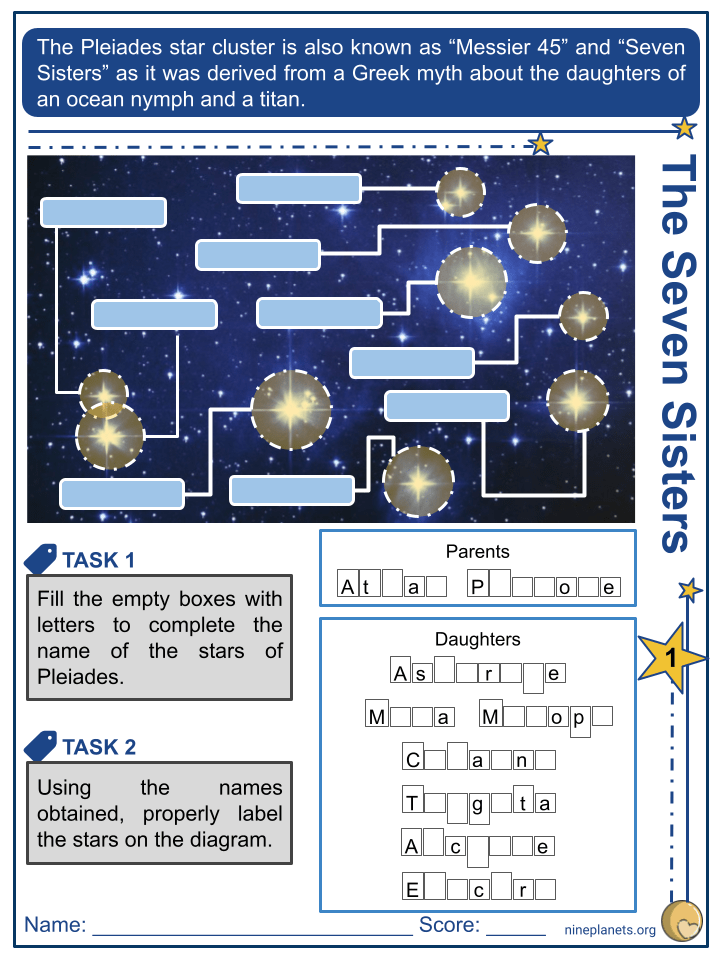Download Pleiades Worksheets
Click the button below to get instant access to these premium worksheets for use in the classroom or at a home.

This worksheet can be edited by Premium members using the free Google Slides online software. Click the Edit button above to get started.
Download free sample
Not ready to purchase a subscription yet? Click here to download a FREE sample of this worksheet pack.
Resource Examples
Click any of the example images below to view a larger version.




Key Facts & Information
- Pleiades is the nearest star cluster to the Earth with the distance of 444.2 light years or 132 parsecs away from the Sun. It is visible to the naked eye, thus can be observed in the sky without the use of a telescope. Pleiades is located at the Taurus constellation with more than 1,000 confirmed stars and around 14 stars visible to the naked eye, best viewed during January. Even though it is very bright, we cannot see it during May and June as the Sun outshines it and blocks our view. The star cluster is thought to have formed together around 100 million years ago which is 1/50 the age of the sun.
Greek Mythology
- During the Ancient war, Atlas rebelled against the King of the Gods, Zeus, who punished him to carry the heavens on his shoulders while the seven sisters caught the eye of a giant huntsman, Orion. However, Zeus stepped in and transformed them into doves, and then into stars as the sisters became sad and the Greek God Zeus allowed them to be close to their father. The Orion constellation represents that Orion is still pursuing the seven sisters across the sky.
Composition
- The cluster core radius is about 8 light years and can stretch for about 17.5 light years, while the tidal radius is about 43 light years.
- Pleiades has an estimated total mass of about 800 solar masses or about 80% of the Sun’s mass.
- The cluster’s apparent dimensions are estimated to be about 110 arc minutes and its apparent magnitude is 1.6.
- Pleiades has middle-aged, hot B-type stars which are believed to be formed 75-150 million years ago. B-type stars are extremely luminous and blue with the surface temperature ranging from 10,000 to 30,000 Kelvin. Given the right conditions, around 14 stars are visible to the naked eye.
- It also has brown dwarfs which constitute around 25% of the total population yet contributes only 2% of its total mass. Brown dwarfs have less than 8% of the Sun’s mass which is not heavy enough for their cores to start nuclear fusion reactions and become proper stars.
- It is estimated that the Pleiades Star Cluster is will continue to exist for another 250 million years and will disperse due to gravitational interactions with the spiral arms of the galaxy and giant molecular clouds.
History
- John Michell – In 1767, he calculated that there was only 1 in 500,000 probability of a chance alignment of many bright stars.
- Edme-Sébastian Jeaurat – He published his observations in 1786 about the Pleiades with a map of 64 stars.
- Galileo Galilei – He first observed the star cluster in a telescope and discovered that Pleiades has a lot of dim stars that are not visible with the naked eye.
- Charles Messier – “Messier 45” was from him as he measured the position of Pleiades and included it as M45 in his catalogue published in 1771.
- Sidereus Nuncius, also known as Starry Messenger or Sidereal Message, is a treatise/pamphlet published by Galileo Galilei in 1610 which includes a sketch of the cluster with 36 stars.
- In the Ancient Mediterranean world, the navigation season was announced by the Pleiades when it first appeared in the morning sky before the sunrise.
- The modern-day festival of Halloween originates from an old Druid rite that coincided with when the cluster reached its highest point in the sky at midnight, when it was believed that the veil dividing the living from the dead was at its thinnest.
- Zuni of New Mexico call the Pleiades “Seed Stars” because its disappearance in the evening sky during spring signals the seed-planting season.
- Māori of New Zealand calls the cluster “Matariki” meaning “eyes of god” or “small” as the heliacal rising of Pleiades signals new year for them.
- Tuareg Berbers of North Sahara call the Pleiades “Cat iheḍ” which means “daughters of the night” and a Tuareg Berber proverb says that when the Pleiades fall as the sun sets on the west, dry summer is coming, and when they rise together at the east, the cold and rainy season is coming.
- In northern Java, Indonesia, the rising of the star cluster signals the arrival of the seventh season – the beginning of rice planting season.
- In the Philippines, Pleiades is also known as “Moroporo” meaning “the boiling lights” or “flock of birds” which marks a new agricultural season, thus, the start of preparation for the new planting season.
- The Makahiki holiday in Hawaii was said to be derived from the other name of Pleiades “Makali’i” meaning small or tiny as the rising of the star cluster also occurs with the change of the harvest time into the beginning of the agricultural season during the lunar months.
- In Swahili of East Africa, the star cluster is called “kilimia” which comes from -lima meaning “dig” or “cultivate” because it signals that the rain is near and they need to start digging to avoid floods.
Reflection Nebulosity
- Lots of reflection nebula are present around the brightest stars of Pleiades and are believed to be remnants from the formation of the cluster.
- However, the reflection nebula in Pleiades is considered to be an unrelated dust cloud in interstellar medium which Pleiades stars are passing through since almost all dust originally present would have been dispersed by radiation pressure at the age of about 100 million years.
- Studies show that the dust responsible for the nebulosity is rather concentrated in two layers along the cluster’s line of sight instead of being uniformly distributed.
Locating Pleiades
- Locate first the Orion constellation and draw a line using Orion’s belt, Alnitak, Alnilam, and Mintaka, then follow it passing through its bow.
- The first bright star you will see past Orion’s bow is the eye of the bull, Aldebaran, which means “follower” in Arabic as it follows the Pleiades across the sky.
- Past the eye of Taurus, you will see the Pleiades Star Cluster which has an arrangement of stars similar to Ursa Major and Ursa Minor.
Legend Of The Lost Pleiad
- Most people see six and not seven Pleiades stars
- Astronomer Robert Burnham Jr. found the lost Pleiad myth dominant in the star lore of African, Asian, European, Indonesian, Native American, and Aboriginal Australian populations
- He suggested that myth may have basis in fact since modern astronomy discovered that Pleione, seventh brightest Pleiades star, is a complicated and hard-to-understand “shell star” with different permutations that causes it to vary in brightness
- Astronomer and writer Agnes Clerke reported that Michael Maestlin, mentor of Johannes Kepler, mapped out 11 pleiades stars before the telescope was invented.
- A dark-sky connoisseur Stephen O’Meara claims that eyes that adapted in the dark for 30 minutes are six times more sensitive to light than those adapted for only 15 minutes
- The constellation Taurus is one of the largest in the night sky and one of the most prominent, occupying an area of 797 square degrees.
- It is also home to another cluster named Hyades, interesting stars such as Aldebaran, it’s eye, and Elnath, fascinating deep-sky objects such as the Crab Nebula, Crystal Ball Nebula, merging galaxies and many more open clusters.
Other Folklore
- According to a Polynesian legend, The Pleiades was once made of a single star and the brightest in the sky. However, Polynesian God Tane did not like how the star bragged about its beauty so it is believed that the god smashed the star into pieces, creating the star cluster.
- To the Vikings, they were the hens of Freyja, one of the major goddesses in Norse mythology, and many old European languages compare the siblings name to a hen with chicks.
- Some Indigenous Australian people believed that Pleiades was a woman nearly raped by the man in the moon, Kidili.
- Gabriella Possum Nungurrayi often paints a dream inherited both from her mother and grandmother. It is a story of the seven Napaltjarri sisters being chased by an admirer, Jilbi Tjakamarra. He would seduce the sisters by practicing love magic but the siblings did not really like him and would run away. They rushed to Kurlunyalimpa when they were searching for honey ants at Uluru and saw Jilbi. The spirits of Uluru transformed them into stars, creating the star cluster, and Jilbi transformed himself into the Morning Star in Orion’s belt, thus still chasing the seven sisters.
- Kiowa of North America linked the origin of the cluster to the Devils tower. Seven little girls were chased by a bear so they climbed a low rock and begged for it to save them. The rock grew higher and higher until they reached the sky. The seven girls became the cluster, Pleiades, and the grooves left on Devils tower are the marks of the bear’s claws.
- In Thailand, Pleiades is known as the “chick stars”. A poor elderly couple lived in a forest and raised a family of chickens: a mother hen, and her six chicks. One day a monk arrived and the couple contemplated cooking the mother hen. The hen overheard and bid goodbye to her children. She told them to take care of themselves and said that her death would repay the kindness of the couple in taking care of them. As the mother hen was burning, the chicks threw themselves into the fire to die along with their mother which impressed the deity. In remembrance of their love, the deity immortalised the chickens as the stars of Pleiades.
- In Japan, the cluster is known as “Subaru” meaning “coming together.” A car manufacturer used it as their logo with the six stars, due to the legend of the lost pleiad, that represent the five companies that merged into one.
- The star cluster is known as “Fiastyúk” in Hungarian folklore, meaning “a hen with chicks” which depicts the story of a poor woman who cursed her seven sons into ravens after they wasted their only food. She received a prophecy that an eighth brother could find her missing sons. The prophecy came true as the eighth son died while finding his brothers and the ravens ate his carcass, which also resulted in their death. The death of the eight of them lead to their place in the sky as the Pleiades.
Did You Know?
- Pleiades is also known as the Seven Sisters and Messier 45 (M45)
- “Pleiades” came from Ancient Greek and is most likely derived from “plein” meaning “to sail” due to its importance in delimiting the sailing season in the Mediterranean Sea: “the season of navigation began with their heliacal rising”
- It is also said to be derived from the name of the sisters’ mother, Pleione, thus meaning “daughters of Pleione”
- The cluster’s stars were named after the ocean nymph Pleione, the titan Atlas and their daughters, namely: Alcyone, Electra, Celaeno, Maia, Merope, Taygeta and Asterope/Sterope.
- In Iran, the star cluster is also known as “Parvin” and is being used as a common name with varieties in the spelling.
- Both mythology and science considered the Pleiades to be sibling stars. Modern astronomers claim that the Pleiades stars were born from the same cloud of gas and dust about 100 million years ago and these stars drift together at about 25 miles per second or 40 kilometers per second. Many of the cluster’s stars shine hundreds of time more brightly than the sun.